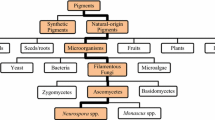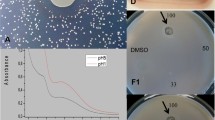Abstract
The search for new sources of natural pigments has increased, mainly because of the toxic effects caused by synthetic dyes used in food, pharmaceutical, textile, and cosmetic industries. Fungi provide a readily available alternative source of natural pigments. In this context, the fungi Penicillium chrysogenum IFL1 and IFL2, Fusarium graminearum IFL3, Monascus purpureus NRRL 1992, and Penicillium vasconiae IFL4 were selected as pigments producers. The fungal identification was performed using ITS and part of the β-tubulin gene sequencing. Almost all fungi were able to grow and produce water-soluble pigments on agro-industrial residues, with the exception of P. vasconiae that produced pigments only on potato dextrose broth. The production of yellow pigments was predominant and the two strains of P. chrysogenum were the largest producers. In addition, the production of pigments and mycotoxins were evaluated in potato dextrose agar using TOF-MS and TOF-MS/MS. Metabolites as roquefortine C, chrysogine were found in both extracts of P. chrysogenum, as well fusarenone X, diacetoxyscirpenol, and neosolaniol in F. graminearum extract. In the M. purpureus extract, the pigments monascorubrin, rubropunctatin, and the mycotoxin citrinin were found. The crude filtrates have potential to be used in the textile industry; nevertheless, additional pigment purification is required for food and pharmaceutical applications.


Similar content being viewed by others
References
Radzio, R., & Kück, U. (1997). Process Biochemistry, 32, 529–539.
Hajjaj, H., Blanc, P. J., Goma, G., & François, J. (1998). FEMS Microbiology Letters, 164, 195–200.
Mapari, S. A. S., Meyer, A. S., & Thrane, U. (2008). Biotechnology Letters, 30, 2183–2190.
Rajasekaran, R., Chandrasekaran, R., & Muthuselvam, M. (2008). Advances in Biotechnology, 7, 19–25.
Pandey, A., Soccol, C. R., Nigam, P., & Soccol, V. T. (2000). Bioresource Technology, 74, 69–80.
Soccol, C. R., & Vandenberghe, L. P. S. (2003). Biochemical Engineering Journal, 13, 205–218.
Daroit, D. J., Silveira, S. T., Hertz, P. F., & Brandelli, A. (2007). Process Biochemistry, 42, 904–908.
Singhania, R.R.; Soccol, C.R.; Pandley, A. (2008) Application of tropical agro-industrial residues as substrate for solid-state fermentation processes. In: Current developments in solid-state fermentation, Springer Science+Business, New York.
Lopes, F. C., Dedavid e Silva, L. A., Tichota, D. M., Daroit, D. J., Velho, R. V., Pereira, J. Q., Côrrea, A. P. F., & Brandelli, A. (2011). Enzyme Research. doi:10.4061/2011/487093.
Horisawa, S., Sakuma, Y., & Doi, S. (2009). Journal of Wood Science, 55, 133–138.
Glass, N. L., & Donaldson, G. C. (1995). Applied and Environmental Microbiology, 61, 1323–1330.
Saitou, N., & Nei, M. (1987). Molecular Biology and Evolution, 4, 406–425.
Kimura, M. (1980). Journal of Molecular Evolution, 16, 111–120.
Silveira, S. T., Daroit, D. J., & Brandelli, A. (2008). LWT Food Science Techonology, 41, 170–174.
Dedavid e Silva, L. A., Lopes, F. C., Silveira, S. T., & Brandelli, A. (2009). Applied Biochemistry Biotechnology, 152, 295–305.
Mapari, S. A. S., Meyer, A. S., & Thrane, U. (2006). Journal of Agricultural and Food Chemistry, 54, 7027–7035.
Senyuva, H. Z., Gilbert, J., & Öztürkoglu, S. (2008). Analytica Chimica Acta, 617, 97–106.
Velmurugan, P., Kamala-Kannan, S., Balachandar, V., Lakshmanaperumalsamy, P., Chae, J. C., & Oh, B. T. (2009). Carbohydrate Polymers, 79, 262–268.
Fungaro, M. H. P. (2000). Biotecnologica Ciencias Desenvol, 3, 12–16.
Einax, E., & Voigt, K. (2003). Organisms, Diversity and Evolution, 3, 185–194.
Bastola, D. R., Out, H. H., Doukas, S. E., Sayood, K., Hinrichs, S. H., & Iwen, P. C. (2004). Mycological Research, 108, 117–125.
Inuma, T., Khodaparast, S. A., & Takamatsu, S. (2007). Molecular Phylogenetics and Evolution, 44, 741–751.
Mapari, S. A. S., Hansen, M. E., Meyer, A. S., & Thrane, U. (2008). Journal of Agricultural and Food Chemistry, 56, 9981–9989.
Wolf, F. T., Kim, Y. T., & Jones, E. A. (1960). Physiological Plant, 13, 621–627.
Mapari, S. A. S., Meyer, A. S., Thrane, U., & Frisvad, J. (2009). Microbial Cell Factories, 8, 1–15.
Asilonu, E., Bucke, C., & Keshavarz, T. (2000). Biotechnology Letters, 22, 931–936.
Nielsen, K. F., & Smedsgaard, J. (2003). Journal of Chromatography. A, 1002, 111–136.
Vishwanath, V., Sulyok, M., Labuda, R., Bicker, W., & Krska, R. (2009). Analytical and Bioanalytical Chemistry, 395, 1355–1372.
Sulyok, M., Krska, R., & Schuhmacher, R. (2010). Food Chemistry, 119, 408–416.
Rasmussen, R. R., Rasmussen, P. H., Larsen, T. O., Bladt, T. T., & Binderup, M. L. (2011). Food and Chemical Toxicololgy, 49, 31–44.
Tor, E. R., Puschner, B., Filigenzi, M. S., Tiwary, A. K., & Poppenga, R. H. (2006). Analytical Chemistry, 78, 4624–4629.
Paterson, R. R. M., Venâncio, A., & Lima, N. (2006). Revista Iberoamericana de Micologia, 23, 155–159.
Prabha, D., D’Souza, L., Kamat, T., Rodrigues, C., & Naik, C. G. (2009). Indian Journal of Marine Science, 38, 38–44.
Lopes, F. C., Tichota, D. M., Sauter, I. P., Meira, S. M. M., Segalin, J., Rott, M. B., et al. (2013). Annals of Microbiology, 63, 771–778.
Acknowledgments
The authors thank Conselho Nacional de Desenvolvimento Científico e Tecnológico (CNPq) and Coordenação de Aperfeiçoamento de Pessoal de Nível Superior (CAPES) for financial support. We also thank Dr. Patricia Valente da Silva, Dr. Charley Christian Staats, Dr. Fernanda Stanisçuaski (UFRGS), and Dr. João Lúcio de Azevedo (ESALQ/USP) for the insightful suggestions on the manuscript and Dr. Nelson Netto (UNICRUZ) for providing some fungi for our mycology collection.
Author information
Authors and Affiliations
Corresponding author
Electronic Supplementary Material
Below is the link to the electronic supplementary material.
Fig. S1
(DOC 997 kb)
Rights and permissions
About this article
Cite this article
Lopes, F.C., Tichota, D.M., Pereira, J.Q. et al. Pigment Production by Filamentous Fungi on Agro-Industrial Byproducts: an Eco-Friendly Alternative. Appl Biochem Biotechnol 171, 616–625 (2013). https://doi.org/10.1007/s12010-013-0392-y
Received:
Accepted:
Published:
Issue Date:
DOI: https://doi.org/10.1007/s12010-013-0392-y




